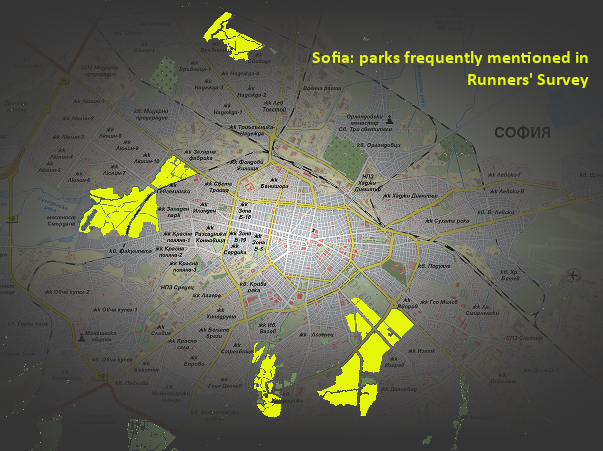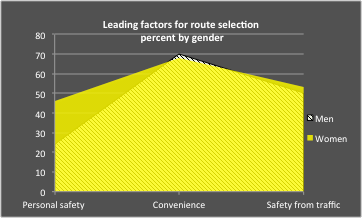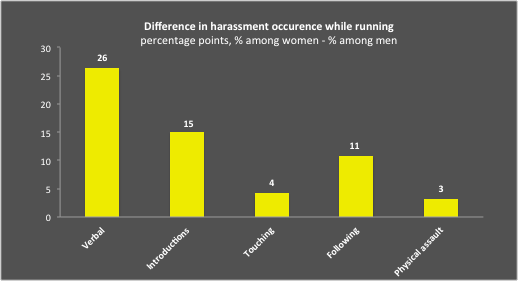Diana Hinova, Sofia, Bulgaria, SSH Blog Correspondent
Sofia boasts several large parks: the South, West and North Parks (no joke on those names), Boris Gardens, and Hunting Park, for instance. For three weeks this autumn, the Runners’ Survey collected information from runners in Bulgaria about their perceptions of safety. The running community is growing here, thanks in part to initiatives like 5km Free Run which hosts organized runs every weekend in several Bulgarian cities. Running is a great, cheap activity that many people can rely on to keep in healthy shape – when the environment allows it. And since we seem to have the infrastructure, and the community, the Runners’ Survey aimed to investigate whether personal safety concerns prevent people from doing so.
Women runners cite personal safety much more often than men (22 percentage point difference) as a leading factor for the selection of where to run. For 12% of women runners this was the sole factor determining where to run (and for 5% of men runners), and not convenience to home or office, or safety from road traffic.
The forms of harassment described by the survey (since the general is not widely familiar in Bulgarian) included unwanted attention in the form of comments, whistling, gestures; attempts to touch; attempts by strangers to introduce themselves; a stranger following the runner; and physical assault. When asked specifically about instances of any of these forms of street harassment while running, 15% of men and 51% of women report having experienced it.
Logically, men runners use harassment avoidance strategies less frequently than women by orders of magnitude. Women runners most often rely on the selection of route and timing of their runs (31%) to avoid street harassment and other threats to their safety. Another common strategy is running with a phone and headphones (22%), although the role of headphones in runners’ safety is interpreted differently by some respondents:
“When running in areas that seem dangerous (eg. Borisov Garden in the dark), I take my headphones off in order to react more quickly if needed.” (w)
“I don’t wear headphones and I scan the surroundings when running” (w)
“I typically run with some friends and don’t pay attention to others in the area. If alone, I would be hesitant to run in an area with no one around or in parks at nighttime, even if there is lighting.” (w)
Women runners also often change their clothing choices (18%) and to a lesser degree rely on group runs, or carry self-defense aids like pepper spray, to avoid street harassment and more serious safety threats. These themes and strategies echo the recent #RWsafety twitter chat, where (mainly US-based) runners shared their experiences, concerns, and hope for change. An additional concern specific to Bulgaria turned out to be the sizable stray dog population.
It is important to consider the effect street harassment, which disproportionately affects the choices of women runners (and potential runners), has on women’s ability to equitably use of public space for healthy activity.
The results of the Runners’ Survey will be communicated to Sofia municipal and local government, officials in the Ministry of Physical Education and Sport, and other interested parties. The full summary of the Runners’ Survey results, along with graphics, can be accessed via the One Billion Rising Sofia Facebook page in English and Bulgarian.
Diana has a Master’s in Public Policy from Georgetown University and works as a consultant to INGOs. Follow her on Twitter @dialeidoscope or letnimletni.blogspot.com.
България: Да си тичаща жена
София се гордее с няколко големи парка: Южния, Западния и Северния, Борисовата Градина, Ловния Парк. тази есен за три седмици Анкета на тичащите събра информация от ентусиастите на бягане в България за усещането им за безопасност. Общността на тичащите се разраства, благодарение отчасти на инициативи като 5km Free Run, които организират безплатни седмични бягания в четири града. Tичането е страхотен, евтин начин за много хора да поддържат добро здравословно състояние – когато средата го позволява. Изглежда имаме инфраструктура за него, и изградена общност, за това Анкета на тичащите цели да разбере дали съображения за безопасност спират някой хора да се възползват от тази възможност.
Тичащите жени много по-често (22 процентни пункта) изтъкват личната си безопасност като водещ фактор при избора къде датичат от мъжете. За 12% от тичащите жени, това е единственият фактор определящ къде да тичат (и при 5% от тичащите мъже), а не удобство до дома и работата или безопасност от автомобилен трафик.
Формите на уличен тормоз описани в анкетата (тъй като цялостното понятие не е твърде познато в България) включват нежелано внимание изразено чрез коментари, подсвирквания, жестове; опити за докосване; нежелени опити за запознанства; следване; и физическо нападение. Запитани дали са били обект на тези проявления, 15% от мъжете и 51% от жените споделят че са срещали уличен тормоз по време на тичане.
Тичащите мъже прилагат стратегии за предпазване от нежелано внимание в пъти по-рядко от жените. Тичащите жени най-често прилагат внимание при подбор на маршрут и час за тичане (31%) за да избегнат нежеланото внимание и други опасности. Друга често срещана стратегия е тичането с телефон и слушалки (22%), въпреки че ефекта от носенето на слушалки при тичане предизвиква противоречиви мнения:
“При минаване през места, които ми се виждат опасни (напр. Борисовата градина по тъмно), свалям слушалките, за да реагирам бързо при нужда.” (ж)
“Не нося слушалки и се оглеждам докато бягам” (ж)
“Обикновенно тичам с компания и не обръщам внимание на околните. Ако съм сама бих се притеснила да тичам на обезлюдено място или в парковте особено на тъмно, дори и мястото да е осветено.” (ж)
Тичащите жени също често внимават в избора на облекло за тичане (18%) и в по-малак степен на тичането с придружител, или носене на защитни средства като спрей, за да избягват нежелано внимание и тормоз. Тези теми са паралели на дискусията в туитър #RWsafety, където тичащи жени (предимно от САЩ) споделиха свои преживявания, притеснения, и желания за промяна. Допълнителен фактор в безопасността на тичащите в България се оказват и бездомните кучета.
Важно е да си дадем сметка за ефекта, който нежеланото внимание оказва предимно върху жените, които тичат (или биха искали да тичат). Това е въпрос на равноправие да се ползват обществените пространства за лично здраве.
Пълно обобщение на резултатите: Анкета на тичащите 2014



